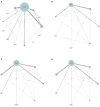Comparative efficacy of exercise modalities for cardiopulmonary function in hemodialysis patients: A systematic review and network meta-analysis
- PMID: 36530731
- PMCID: PMC9751492
- DOI: 10.3389/fpubh.2022.1040704
Comparative efficacy of exercise modalities for cardiopulmonary function in hemodialysis patients: A systematic review and network meta-analysis
Abstract
Background: To provide reliable evidence to exercise rehabilitation therapists and clinicians, we compared and analyzed the effects of different exercise modalities on cardiopulmonary function in hemodialysis patients using Bayesian network meta-analysis.
Methods: PubMed, OVID, Web of Science, Cochrane Library, Embase, Scopus, CINAHL, SPORT Discus, SinoMed, CNKI, Wanfang, and VIP were searched from inception to July 20, 2022. We included randomized controlled trials comparing 12 exercise modalities to improve cardiorespiratory fitness in hemodialysis patients. All statistical analysis was performed using STATA and R.
Result: A total of 82 randomized controlled trials involving 4146 maintenance hemodialysis patients were included in this study. The pair-wise meta-analysis showed that all exercise modalities had a positive effect on all indicators of cardiorespiratory capacity. The network meta-analysis demonstrated that Blood flow restriction training (BFRT), Cycle exercise (CE), Inspiratory muscle training (IMT), Combined aerobic and resistance training (CT), and Aerobic training (AT) were significantly better than usual care for 6-min walkability; Medium intensity continuous training (MICT), CT, CE, and AT were considerably better than usual care for VO2Peak; body and mind training (MBT) and CT significantly improved SBP compared to usual care; and only MBT was significantly better than usual care for DBP. Both the two-dimensional plot and the radar plot demonstrated that CT had the best combined-effect on each index of cardiorespiratory fitness. Subgroup and sensitivity analyses demonstrated the robustness of the results. The evidence was mainly "low" to "very low" for this network meta-analysis.
Conclusion: There is no one exercise that can achieve the best effect on all of the outcomes. The benefits of MBT in decreasing arterial blood pressure are unsurpassed by other exercise methods. The intervention effect of the CT is better and more stable. Electrical muscle stimulation training (MEST) can be employed in individuals who do not wish to exercise actively but may cause an increase in blood pressure. On the basis of the characteristics of different exercise types, guidelines developers, clinicians, and patients may employ them appropriately.
Systematic review registration: https://www.crd.york.ac.uk/PROSPERO/#recordDetails.
Keywords: Bayesian network meta-analysis; cardiopulmonary function; chronic kidney failure; exercise; renal dialysis.
Copyright © 2022 Zang, Fang, He, Mu, Zheng, Shu, Ge and Wang.
Conflict of interest statement
The authors declare that the research was conducted in the absence of any commercial or financial relationships that could be construed as a potential conflict of interest.
Figures




Similar articles
-
Systemic pharmacological treatments for chronic plaque psoriasis: a network meta-analysis.Cochrane Database Syst Rev. 2017 Dec 22;12(12):CD011535. doi: 10.1002/14651858.CD011535.pub2. Cochrane Database Syst Rev. 2017. Update in: Cochrane Database Syst Rev. 2020 Jan 9;1:CD011535. doi: 10.1002/14651858.CD011535.pub3. PMID: 29271481 Free PMC article. Updated.
-
Falls prevention interventions for community-dwelling older adults: systematic review and meta-analysis of benefits, harms, and patient values and preferences.Syst Rev. 2024 Nov 26;13(1):289. doi: 10.1186/s13643-024-02681-3. Syst Rev. 2024. PMID: 39593159 Free PMC article.
-
Systemic pharmacological treatments for chronic plaque psoriasis: a network meta-analysis.Cochrane Database Syst Rev. 2021 Apr 19;4(4):CD011535. doi: 10.1002/14651858.CD011535.pub4. Cochrane Database Syst Rev. 2021. Update in: Cochrane Database Syst Rev. 2022 May 23;5:CD011535. doi: 10.1002/14651858.CD011535.pub5. PMID: 33871055 Free PMC article. Updated.
-
Systemic pharmacological treatments for chronic plaque psoriasis: a network meta-analysis.Cochrane Database Syst Rev. 2020 Jan 9;1(1):CD011535. doi: 10.1002/14651858.CD011535.pub3. Cochrane Database Syst Rev. 2020. Update in: Cochrane Database Syst Rev. 2021 Apr 19;4:CD011535. doi: 10.1002/14651858.CD011535.pub4. PMID: 31917873 Free PMC article. Updated.
-
Drugs for preventing postoperative nausea and vomiting in adults after general anaesthesia: a network meta-analysis.Cochrane Database Syst Rev. 2020 Oct 19;10(10):CD012859. doi: 10.1002/14651858.CD012859.pub2. Cochrane Database Syst Rev. 2020. PMID: 33075160 Free PMC article.
Cited by
-
Cardiorespiratory fitness and mortality risk in patients receiving hemodialysis: a prospective cohort.J Bras Nefrol. 2024 Jan-Mar;46(1):39-46. doi: 10.1590/2175-8239-JBN-2022-0124en. J Bras Nefrol. 2024. PMID: 37497828 Free PMC article.
-
Comparative efficacy of exercise modalities for general risk factors, renal function, and physical function in non-dialysis chronic kidney disease patients: a systematic review and network meta-analysis.Ren Fail. 2024 Dec;46(2):2373272. doi: 10.1080/0886022X.2024.2373272. Epub 2024 Jul 5. Ren Fail. 2024. PMID: 38967189 Free PMC article.
-
Comparative efficacy of different exercise methods to improve cardiopulmonary function in stroke patients: a network meta-analysis of randomized controlled trials.Front Neurol. 2024 Jan 17;15:1288032. doi: 10.3389/fneur.2024.1288032. eCollection 2024. Front Neurol. 2024. PMID: 38313560 Free PMC article.
-
Meta-analysis of the effects of exercise interventions on dialysis patients with cardiac function disorders.Front Med (Lausanne). 2025 May 13;12:1573498. doi: 10.3389/fmed.2025.1573498. eCollection 2025. Front Med (Lausanne). 2025. PMID: 40432722 Free PMC article.
-
Quantifying the dose-response relationship between exercise and health-related quality of life in patients undergoing haemodialysis: A meta-analysis.Prev Med Rep. 2024 Apr 20;42:102737. doi: 10.1016/j.pmedr.2024.102737. eCollection 2024 Jun. Prev Med Rep. 2024. PMID: 38707251 Free PMC article. Review.
References
-
- Murray R, Zimmerman T, Agarwal A, Palevsky PM, Quaggin S, Rosas SE, et al. . Kidney-related research in the United States: a position statement from the National Kidney Foundation and the American Society of Nephrology. Am J Kidney Dis. (2021) 78:161–7. 10.1053/j.ajkd.2021.04.006 - DOI - PMC - PubMed

